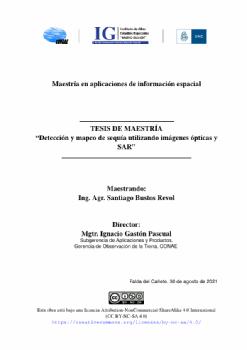| dc.contributor.advisor | Pascual, Ignacio Gastón | |
| dc.contributor.author | Bustos Revol, Santiago | |
| dc.date.accessioned | 2021-09-03T13:59:10Z | |
| dc.date.available | 2021-09-03T13:59:10Z | |
| dc.date.issued | 2021 | |
| dc.identifier.uri | http://hdl.handle.net/11086/20084 | |
| dc.description | Tesis (Magister en aplicaciones de información espacial)--Universidad Nacional de Córdoba, Facultad de Matemática, Astronomía, Física y Computación, 2021. | es |
| dc.description | Maestría conjunta entre FAMAF y el Instituto de Altos Estudios Espaciales "Mario Gulich" CONAE/UNC. | es |
| dc.description.abstract | En este trabajo se utilizó el algoritmo SVR a escala local para medir la performance en la estimación de la humedad de suelo a partir de imágenes SAR principalmente, aunque también se utilizaron otras fuentes de información complementaria como: temperatura y precipitaciones (extraídas de una estación meteorológica local), datos de NDVI (extraídos del sensores ópticos como Sentinel-2), índices de sequía como PDSI y de vegetación como VCI (este último fue extraído a partir de imágenes MODIS). El objetivo fue comprobar si existió algún tipo de déficit hídrico detectado con imágenes SAR, que pudiera haber afectado a los
cultivos agrícolas en la zona de Bell Ville- Monte Buey en el la campaña agrícola 2017/18. Los resultados del coeficiente de determinación no superaron valores de 0.5 a pesar de haber utilizado variables complementarias que aportaron información para explicar la humedad del suelo y la influencia de la vegetación en ésta. Se concluyó que no es adecuado la utilización del algoritmo SVR para recuperar la humedad de suelo a partir de sensores banda C con las polarizaciones VH y VV sobre lotes agrícolas en el área estudiada. Por otro lado se realizaron mapas de déficit hídrico donde se identificaron cuales son las posibles áreas bajo régimen de sequía, cual fue su intensidad, su duración y como fue la dinámica de la sequía en el tiempo. Además fue factible calcular la superficie bajo estrés en cada fecha de manera general y discriminando por intensidad del estrés (déficit hídrico leve,
moderado o severo). La confiabilidad de los resultados podría incrementarse a medida que aumente la duración de la serie. | es |
| dc.description.abstract | In this work the SVR algorithm was used at a local scale to measure the performance in the estimation of soil moisture from SAR images mainly, although other sources of complementary information were also used such as: temperature and precipitation (extracted from a local weather station), NDVI data (extracted from optical sensors such as Sentinel-2), drought indices such as PDSI and vegetation indices such as VCI (the latter was extracted from MODIS images). The objective was to check if there was any type of water deficit detected with SAR images, which could have affected agricultural crops in the area of Bell Ville- Monte Buey in the 2017/18 agricultural year. The results of the determination coefficient values did not exceed 0.5 despite using complementary variables that provided information to explain soil moisture and the vegetation influence on the soil. It was concluded that it is not appropriate to use the SVR algorithm to recover soil moisture from C-band sensors with VH and VV polarizations on agricultural fields in the studied area. On the other hand, water deficit maps were made where the possible areas under drought regime were identified, what was its intensity, its duration and how was the dynamics of drought in time. It was also feasible to calculate the area under stress in a general way and discriminating by stress intensity (mild, moderate or severe water deficit). The reliability of the results could be increased with increasing duration of the series. | en |
| dc.language.iso | spa | es |
| dc.rights | Atribución-NoComercial-CompartirIgual 4.0 Internacional | * |
| dc.rights.uri | http://creativecommons.org/licenses/by-nc-sa/4.0/ | * |
| dc.subject | Radar de apertura sintética | es |
| dc.subject | Banda C | es |
| dc.subject | Humedad de suelo | es |
| dc.subject | Sequía | es |
| dc.subject | Synthetic aperture radar | en |
| dc.subject | Support vector regression | en |
| dc.subject | Applied computing | en |
| dc.subject | Computers in other domains | en |
| dc.subject | Agriculture | en |
| dc.subject | SAR | en |
| dc.title | Detección y mapeo de sequía utilizando imágenes ópticas y SAR | es |
| dc.type | masterThesis | es |
| dc.description.version | publishedVersion | |
| dc.description.fil | Fil: Bustos Revol, Santiago. Universidad Nacional de Córdoba. Facultad de Matemática, Astronomía, Física y Computación; Argentina. | es |
| dc.description.fil | Fil: Bustos Revol, Santiago. Universidad Nacional de Córdoba. Instituto de Altos Estudios Espaciales Mario Gulich; Argentina. | es |
| dc.description.fil | Fil: Bustos Revol, Santiago. Comisión Nacional de Actividades Espaciales. Instituto de Altos Estudios Espaciales Mario Gulich; Argentina. | es |





